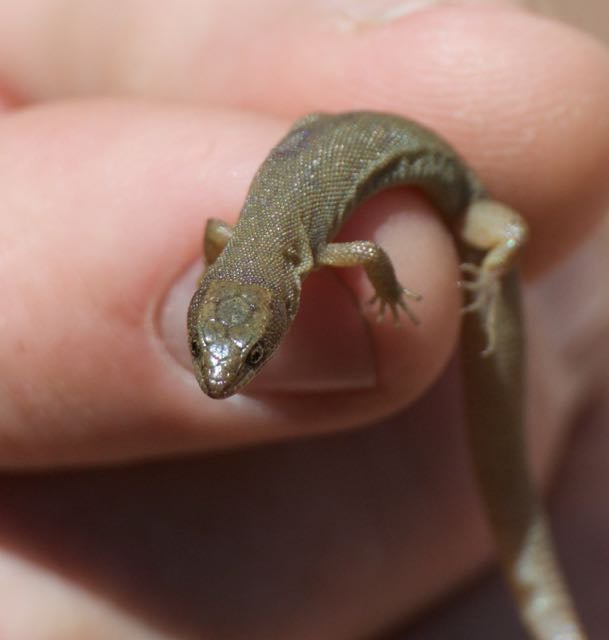Naturalist update from 7/31
They say the time for discovery is over. Rubbish.Looks like it will hit 120 F today — way too hot for enjoying the outdoors. However, it is a good day for reading a book. Perhaps you won’t be too surprised that I love to read books, especially about people doing science (yes, I am a total nerd). My current read is a book about night lizards by Robert Bezy. Those of you who have been in the field with me know that I rarely walk by a yucca branch or a dead yucca rosette without flipping it over, and then carefully replacing it, to see if there might be a night lizard living there. Maybe every 20th or 30th try, there will be one of these mysterious (to me) lizards. Just to pass along what little I know:
• Despite their name, they aren’t necessarily nocturnal. Because most night lizard species have vertical, cat or snake-like pupils, early naturalists assumed they were nocturnal. According to Bezy, captive animals can be active day or night.
• Except for one species that lives in Cuba, night lizards give birth to live young – the technical term is viviparous – usually 1-2 young at a time.
• Night lizards live in family groups often under a pile of yucca branches, rarely if ever venturing beyond those branches their entire life.
• According to Bezy, their primary sustenance comes from eating ants. I always thought it was termites.
• As a family (Xantusiidae), they are restricted to the southwestern U.S. (including some of the Channel Islands off the coast of Santa Barbara), and extend through Mexico and Central America. And then there is that one in Cuba.
• The one in Cuba is an enigma. The only night lizard in the Caribbean, the only one that lays eggs, and it separated from the main stem of night lizards some 81 million years ago. Remember that asteroid/comet that struck the Caribbean about 64 million years ago? The one that took out the remaining non-bird dinosaurs? When it hit, it created an enormous wave that would have engulfed whatever proto-Cuban landmass that existed at that time. Yet this night lizard survived when not much else did. Living deep in cracks between limestone boulders and rocks apparently has advantages.
So, they are interesting beasts, but the real enjoyment I’ve gotten from reading this book is learning of the exploits of the young 20-something Robert Bezy had in his search for night lizards. This was back in the 1960s. Descriptions of driving through mainland Mexico, then across on the ferry to La Paz, Baja California, and then up the entire length of the peninsula – all on dirt roads, barely enough money, flat tires and broken-down vehicles – all conjured images of amazing adventures that few of us would risk today.
Not unlike the young Charles Darwin, a mere 22-year-old with no formal training in biology (only a bit of Geology) setting out on the Beagle for what was to be a 2-3-year voyage, that turned into more than 5 years at sea. Something about seeing new, changing landscapes, each with its own plants and animals (including night lizards), that stimulates one’s mind to think about patterns in nature, creating the foundation for developing hypotheses that might explain those patterns.
We have at least two species of night lizards here in the mountains and foothills surrounding the Coachella Valley – the desert or yucca night lizard, Xantusia vigilis, and the rock-crevice living Baja California species that extends it range to the Coachella Valley, the granite night lizard, X. henshawi. A student from one of the classes I taught at the College of the Desert had found a population of granite night lizards in the boulders a bit higher than the top of the tram, well over 8,000’ in elevation and the highest ever officially recorded for that species. I recently heard a story of someone who helped build or rebuild the trail up to San Jacinto peak who, back in the 1950s or 1960s found lizards hiding in the rocks at elevations above 9,000’ – the only possible candidate would be a granite night lizard. There are more discoveries to be made.
A more recent finding was a population of night lizards on the north side of the Borrego Valley living in sandstone crevices. It turned out to be different enough to be a new species X. riversiana, the sandstone night lizard. There also may be another species X. wigginsi that comes up from Baja California, but no one knows how far north they get.There may be more to come. The desert night lizards that live in the San Jacinto and Santa Rosa mountains have been lumped with those that extend through the Mojave Desert and across into Arizona. For a lizard that rarely moves beyond its clump of yucca branches, that is a huge range. Maybe too big, and so it could be time to take another look at them with new and better DNA analyzing techniques.
I sometimes hear that the time of discovery, for being the first to find new species, is over. Rubbish.
